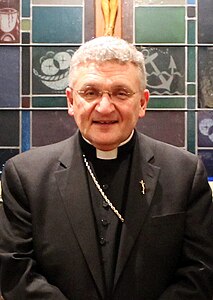David Zubik
 | |||
| |||
| Kraj działania | Stany Zjednoczone | ||
|---|---|---|---|
| Data i miejsce urodzenia | 4 września 1949 Sewickley | ||
| Biskup Pittsburgha | |||
| Okres sprawowania | od 2007 | ||
| Biskup Green Bay | |||
| Okres sprawowania | 2003–2007 | ||
| Wyznanie | katolicyzm | ||
| Kościół | Kościół łaciński | ||
| Prezbiterat | 3 maja 1975 | ||
| Nominacja biskupia | 18 lutego 1997 | ||
| Sakra biskupia | 6 kwietnia 1997 | ||
| Data konsekracji | 6 kwietnia 1997 | ||||||||
|---|---|---|---|---|---|---|---|---|---|
| Miejscowość | Pittsburgh | ||||||||
| Miejsce | Katedra św. Pawła | ||||||||
| Konsekrator | Donald Wuerl | ||||||||
| Współkonsekratorzy | Nicholas Dattilo Thomas Tobin | ||||||||
| |||||||||
| |||||||||
David Zubik (ur. 4 września 1949 w Sewickley) – amerykański biskup katolicki polskiego pochodzenia[1], biskup diecezji Pittsburgh od 2007.
Życiorys
Święcenia kapłańskie przyjął 3 maja 1975 i został inkardynowany do diecezji Pittsburgh. Pracował m.in. jako biskupi sekretarz (1987-1991), kanclerz kurii (1995-1996) oraz jako wikariusz generalny diecezji (1996-1997)[2].
18 lutego 1997 został mianowany biskupem pomocniczym Pittsburgha oraz biskupem tytularnym Jamestown[3]. Sakry biskupiej udzielił mu 6 kwietnia 1997 ówczesny biskup Pittsburgha, Donald Wuerl[2].
10 października 2003 papież Jan Paweł II mianował go biskupem Green Bay[3]. Ingres odbył się 12 grudnia 2003[2].
18 lipca 2007 został mianowany biskupem swojej rodzinnej diecezji[4], zaś 28 września 2007 kanonicznie objął urząd[2].
Przypisy
- ↑ Krzysztof Prokop. Biskupi Kaszubi w „Nowym Świecie” oraz sukcesja apostolska ich i pozostałych katolickich biskupów z Kaszub. „Acta Cassubiana”. nr 12, s. 216, 2010. ISSN 1509-5703.
- ↑ a b c d Bishop Zubik (ang.). Diecezja Pittsburgh. [dostęp 2019-09-20].
- ↑ a b RINUNCIA DEL VESCOVO DI GREEN BAY (U.S.A.) E NOMINA DEL SUCCESSORE (wł.). vatican.va, 2003-10-10. [dostęp 2019-09-20].
- ↑ NOMINA DEL VESCOVO DI PITTSBURGH (U.S.A.) (wł.). vatican.va, 2007-07-18. [dostęp 2019-09-20].
Bibliografia
- David Zubik w bazie catholic-hierarchy.org (ang.)
Media użyte na tej stronie
(c) I, SajoR, CC BY-SA 2.5
Coat of arms of the U.S. bishop David Allen Zubik, Bishop of Pittsburgh.
Significance: By tradition, Bishop Zubik’s personal coat of arms is joined to the coat of arms of the Diocese of Pittsburgh.
The arms of the Diocese of Pittsburgh (left side) were designed by the late Pierre Chaignon la Rose and show a black field on which are placed a blue and white chequy bar, a sword, and two crosses, all gold. The black color of the field is appropriate to the city of Pittsburgh; and the chequy bar stands for a counting board, all based on the arms granted to William Pitt who was chancellor of the Exchequer of England and for whom the City of Pittsburgh is named. The colors of the bar in the original Pitt grant were changed to silver and blue; and the coins of the treasury were transformed into globical convexed crosses. The sword was added in honor of Saint Paul, the patron Saint of the Cathedral of Pittsburgh.
Bishop Zubik’s coat of arms (right side) begins at the top with the arched span symbolizing his native Ambridge and much of southwestern Pennsylvania, which are home to bridges and bridge builders. Pittsburgh has been called the “city of bridges.” As a successor of the apostles, Bishop Zubik has been entrusted with preserving and protecting the truth of the faith by building and maintaining the bridge which ensures, in all times and places, the continuity in faith between Christ and his Church.
The golden wheat sheaf represents the fruit of the earth. God is the Father of all gifts. The gift of Bishop Zubik’s vocation was recognized and nurtured by Father Edward R. Farina whose surname means “grain” or “wheat.” Wheat is also the work of human hands. Bishop Zubik’s Polish and Slovak ancestors are not strangers to labor and toil – values held dear to the Bishop himself. Wheat can be transformed into bread, the simple food for much of the world. Of most importance, the wheat sheaf symbolizes the Eucharist, the bread of eternal life which feeds and nourishes God’s people. Further, the name Zubik comes from the Polish word “zlobek” which means “wheat,” highlighting that Jesus is the Bread of Life. The sheaf is placed in a field of green, the color of life and hope.
The letter “M” represents the Blessed Mother for whom the Bishop has a special devotion, passed on to him by his maternal grandmother. The symbol imitates the coat of arms of His Holiness, the late Pope John Paul II, who called Bishop Zubik to the episcopacy in 1997. In the Gospel of Luke, Mary is portrayed as the first faithful disciple, the one who heard and heeded God’s word. Mary’s discipleship inspires Bishop Zubik who pledges his faithful obedience to the will of God and to the Vicar of Christ on earth.
The simple cross holds the coat of arms. The cross of Jesus Christ is the power of God which is the foundation of Bishop Zubik’s commitment to be a bridge which draws those whom he serves to God.
Over the whole coat of arms is a bishop’s hat, or galero, with six tassels pendant on each side, in three rows, all in green, for a bishop.
Motto: The scroll beneath the coat of arms contains Bishop Zubik’s motto, “Nothing is Impossible with God,” and comes from Luke 1:37 where the angel Gabriel visits Mary and reveals to her that she is about to bear the son of God. When Mary asks how this can be since she is a virgin, Gabriel offers his reply: “Nothing is Impossible with God.”
Reference:
Autor: Alekjds, Licencja: CC BY-SA 3.0
The Most Reverend David A. Zubik, the Bishop of the Roman Catholic Diocese of Pittsburgh.


